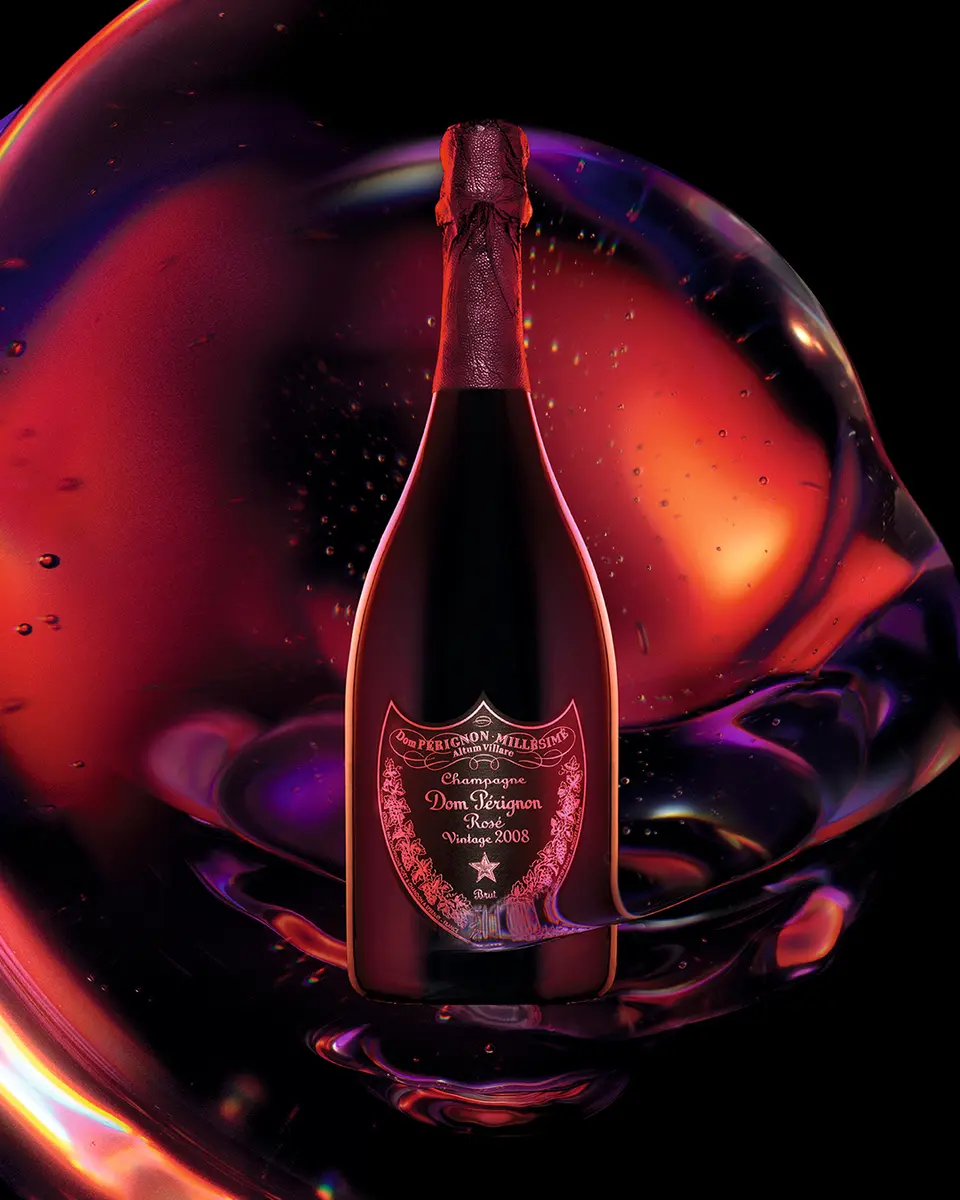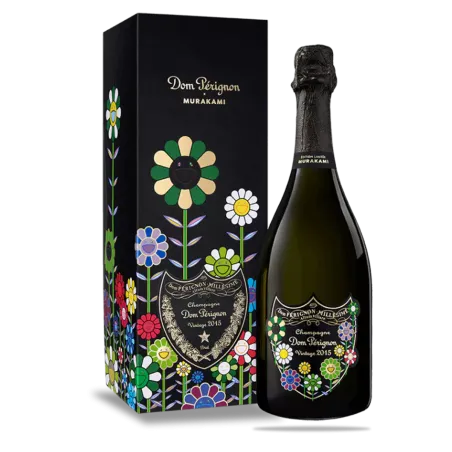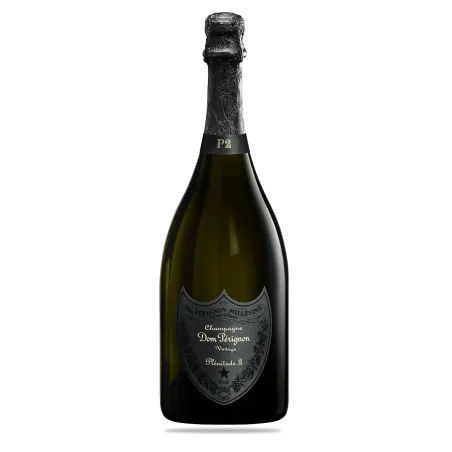
Champagne Dom Pérignon owes its name to the famous monk and procurator of Hautvillers Abbey in 1668, Pierre Pérignon (known as Dom Pérignon). Legend has it that Pierre Pérignon discovered what is now known as the méthode champenoise. In 1669, he taught this method to the Benedictine monk Thierry Ruinart, who thus enabled another famous Champagne house, Ruinart, to become the first Champagne house in 1729.
The Champagne brand Dom Pérignon is a Champagne House directly inspired by and imbued with Pierre Pérignon's philosophy, which lies in the quest for the ultimate perfection of Champagne wine.
The vintages
Dom Pérignon
Dom Pérignon Vintage Jean-Michel Basquiat Édition Spéciale 2015 without box (EN)
Dom Pérignon Basquiat Édition Spéciale 2015 (3 bottles and boxes)
Dom PErignon
vintage
ELEGANCE
AND DELICACY
The creation of the 2013 vintage reveals the play of resonance between Pinot Noir and Chardonnay, acidity and roundness. Its precise, elegant and tactile bouquet unfurls a delicate, aromatic flavor around three nuances: citrus, a more vegetal facet and, finally, spices. This precision reveals an elegance where the wine, after an airy attack, amplifies.

Dom PErignon
Rosé
A RADICAL
ASSEMBLY
Dom Pérignon Rosé ventures into 2008, playing with all the nuances of Pinot Noir to reveal the radical character of Dom Pérignon Rosé Vintage 2008.
Dom Perignon
Plénitude 2
EASE AND GENORISITY
The bouquet of Dom Pérignon Vintage 2004 Plénitude 2 develops in a balance that is both airy and well-balanced.
The history of Dom Pérignon,
world-famous champagne
The story of Dom Pérignon begins almost three centuries ago. Born in 1638 in Sainte-Menehould in Argonne, could Pierre Pérignon have imagined that he would become the "spiritual father of Champagne"? One thing's for sure: his name has spanned the centuries, fuelling debate. Legend has it that Pierre Pérignon discovered what is now known as the méthode champenoise.
Ordained a priest in 1667, Dom Pierre Pérignon took up his post as cellarer at Hautvillers Abbey in 1668. Located not far from Épernay, in the Marne region of Champagne, Hautvillers Abbey was founded around 650 by the archbishop of Reims, Saint-Nivard. The magnificent architectural ensemble, now owned by Moët & Chandon, was renovated under the impetus of Catherine de Médicis in the 16th century, after having been destroyed and rebuilt many times. Upon his arrival, Dom Pierre Pérignon continued the renovation work, while also erecting new buildings. Written documents testify to the fact that he was called "Dom Pieærre" or "Dom procureur". In charge of managing monastic affairs and ensuring that the vineyard business flourished, Dom Pérignon distinguished himself by his ability to make still wines with grapes from "la Montagne" and "la Rivière". Having gone blind, it is said that Dom Pérignon tasted grapes from different Champagne crus and varietals to create blends. He was endowed with a keen sense of taste, enabling him to identify the typicity of a cru by classifying them according to the year of harvest.
Dom Pierre Pérignon mastered every stage of wine-making, from viticulture to blending and vinification.
The stamp on Champagnes Dom Pérignon
Much more than a world-famous brand, "Dom Pé" embodies French luxury and, above all, a unique style. Whether you're a passionate connoisseur or a discerning onlooker, there's no mistaking it. Champagne Dom Pérignon has that unmistakable chic and unwavering consistency of quality that makes it an instant tasting experience to remember Dom Pérignon.
Champagne emblématique, Dom Pérignon is also closely associated with the first James Bond films. In 1962's James Bond 007 vs. Dr. No, James Bond grabs a bottle of Dom Pérignon 1955 to defend young Honey, and puts it back, ironically declaring "I prefer the 1953".
In addition to collaborations with artists, Dom Pérignon Champagne is available in three phases: P1, P2 and P3. This concept of "Plénitude" makes it possible to discover the evolution of a Champagne Dom Pérignon at different stages of its maturation and therefore of its evolution.
From the great Vintage 1998 to the Rosé 1996 Plénitude 2, not forgetting the Rosé Vintage 2006 or the very concentrated Vintage 2003, VINTAGE 2012, DOM PÉRIGNON X LADY GAGA VINTAGE 2010, VINTAGE ROSÉ 2008, VINTAGE BLANC 2003 PLÉNITUDE 2, each vintage of Dom Pérignon invites us to discover the expression of a year. Like an orchestra conductor, the cellar master brings together terroirs to create a unique and exceptional composition. Each year, the cellar master creates the story of a new vintage, preserving the brand's style while revealing the unique expression of that exceptional year.
For him, the questions that must constantly remain in the mind of the Chef de Caves are: "What will the declaration of a new vintage bring to the story of Dom Pérignon savoir-faire?"
In 2019, Vincent Chaperon, working closely with Richard Geoffroy during thirteen years of apprenticeship, succeeds him.
When connoisseurs talk about dom, they're referring to champagne, not to the Benedictine monk. Launched in the 1930s, Dom Pérignon was Moët & Chandon's standard-bearer for a long time, but in recent decades it has acquired its own identity.
"This is the place where Dom Pierre Pérignon, a Benedictine monk, devoted 47 years of his life to inventing and perfecting techniques to create a wine whose reputation became unparalleled."
The word "technique" reminds us that the monk was not the inventor of champagne. Pierre Pérignon pushed the art of creation to a level of perfection never before equaled in Champagne: he developed precise viticultural techniques to improve grape quality, reworked the blends of different crus and opted for fractional, but less aggressive, pressing to obtain white juices from black grapes.
The myth of Dom Pérignon, who died in 1715, was born long after his death. His memory was revived in the 1820s, when Pierre-Gabriel Chandon, who had just married Adélaïde Moët, acquired the vineyards and the former abbey of Hautvillers. It was in 1932, when sales suffered the setbacks of the recession, that the Champenois - very inspired - decided to celebrate the 250th anniversary of the monk's great "invention". A totally arbitrary date, but one that did indeed succeed in stimulating demand.
That same year, at a meeting of the Syndicat des grandes marques, a consultant by the name of Lawrence Venn suggested launching a brand of absolute luxury. Given the state of the world economy, his proposal must have sounded as stupid as Marie-Antoinette's famous declaration: "Let them eat brioche"! But the idea caught the attention of Robert-Jean de Vogüé, Moët & Chandon's new sales director, who invited Venn to dinner to draw up a battle plan to create Dom Pérignon.
The champagne was released in London in 1935, in a replica of a 16th-century bottle with an imposing shield-shaped label. The Cuvée Centenaire still doesn't mark the birth of the monk, but the hundredth anniversary of Simon Brothers, Moët's British representatives, who wanted to offer their hundred best customers an exceptional wine.
The 1926 vintage did not yet bear the famous name, but word of it reached as far as America. The following year, a shipment of just 100 cases was sent to New York aboard the French luxury liner Normandie. This time, it was an older, high-end vintage from 1921, which indeed bore the name Dom Pérignon.
How much does Dom Pérignon cost?
The price of a bottle of Dom Perignon champagne depends strongly on the quality of the vintage and its age. On average, a bottle of Dom Perignon costs around 225€ DOM PÉRIGNON X LADY GAGA VINTAGE 2010 . Recent vintages are more likely to cost around €215 (DOM PÉRIGNON VINTAGE 2012 )while older, and therefore rare, vintages can reach €500 (DOM PÉRIGNON VINTAGE BLANC 2003 PLÉNITUDE 2).
What's the most expensive Dom Perignon?
The most expensivebottle of Dom Perignon is a Dom Perignon Rosé Vintage Gold in Methuselah format, which sells for €50,000. The bottle is so elegant that anyone who looks at it will literally fall in love.
Why was the Dom Pérignon myth created?
The reasons behind the myth of Dom Pérignon, the "inventor" of sparkling Champagne, are purely commercial. Abbaye de Hautvillers, owned by Mercier, is now part of Moët & Chandon, since the latter acquired Mercier. The myth was born when Moët & Chandon created the prestige cuvée Dom Pérignon.
Who owns Dom Pérignon?
LVMH (Moët Hennessy - Louis Vuitton) is the owner of Dom Pérignon. It is a French multinational company that designs, produces and distributes luxury goods.
What are the best Dom Perignon vintages?
DOM PÉRIGNON MILLÉSIME 1996
Robert Parker score: 98 / 100
Great acidity and enormous intensity of flavor, backed by vibrant acidity, make this an exquisite champagne. It should drink well for 25 years, perhaps longer. It's worth remembering that Dom Perignon's 1971 Cuvée Rosé still drinks exquisitely. It makes you realize just how long-lived these sparkling wines can be. Production is confidential. This is a rare and exceptional champagne.
DOM PÉRIGNON MILLÉSIME 1990
Robert Parker score: 98 / 100
Intense lemon and straw color. A fragrant nose with intense aromas of jasmine, cinnamon, buttered toast, applesauce and candied ginger. On the palate, it's a concentrate of honey and nuts, warm apple pie and spices. This gives it a fine structure and you'll notice a very long finish. Drink now.
DOM PERIGNON MILLÉSIME 2008
Robert Parker score: 96+ / 100DomPerignon 2008 is the finest release of this iconic cuvée since the 1996 vintage. On the palate, the wine is medium-bodied, deep and complete, its notable flesh and amplitude controlled by incisive acids, with a youthful, exuberant yet elegant mousse and a long, beautifully delineated finish. This is a remarkable achievement and a fitting release to conclude Richard's tenure as cellar master. Geoffroy
DOM PÉRIGNON MILLÉSIME 1985
Robert Parker rating: 96 / 100
On the nose, you'll experience a very floral attack that gives way to notes of acacia honey and candied fruit. The wine is full-bodied and vinous on the palate. Notes of figs and grapes dominate, then give way to undergrowth. An exceptional year has produced a great Dom Pérignon. Drink now.
DOM PÉRIGNON MILLÉSIME 1982
Robert Parker score: 96 / 100Abeautiful yellow color with green highlights. A nose with notes of honey and roasted almonds. A very light, abundant mousse. An elegant Dom Pérignon with a tenacious finish. Drink now.
DOM PÉRIGNON MILLÉSIME 2005
In the 2000s from Dom Pérignon we recommend the 2005 rated 94 / 100 by Wine spectator:
On the nose, we notice this bouquet of great richness. Intense black fruit notes, with significant minerality. Wrapping everything up are superb notes of praline and coriander.
On the palate, the wine has real character. It asserts its presence firmly, is structured and solid. The finish features spicy, floral notes that linger with every sip.
How many bottles of Dom Perignon are produced each year?
Dom Pérignon is a vintage cuvee made from Champagne wine. It is produced in exceptional years by Champagne Moët & Chandon, and is sold in 8 million bottles.
Dom perignon what year?
Dom perignon what year? The famous Dom Perignon sparkling wine is produced by the Moët & Chandon champagne house. It is made from black grapes grown in Grand Cru vineyards, mainly on the Montagne de Reims. The Dom Perignon cuvée is only produced in exceptional years, when climatic conditions are conducive to optimal ripening of the grapes.
What's the rarest champagne?
The rarest champagne is Dom Pérignon Rosé 1953. This champagne is so rare that only 12 bottles were ever produced. The most expensive bottle sold at auction was a bottle of Dom Pérignon Rosé 1953, which sold for $275,000.
How much does a bottle of dom pérignon cost?
The price of a bottle of Dom Pérignon can vary considerably depending on the year of production and the place of purchase. In general, you can expect to pay between 150 and 200 euros for a recent bottle. Older and rarer vintages can cost several thousand euros.
What's the best champagne in the world?
This is a subjective question, as the "best" champagne depends on individual preferences. However, certain names come up frequently, such as Dom Pérignon, Louis Roederer Cristal and Krug Grande Cuvée. These brands are renowned for their exceptional quality and distinctive taste.
What's the most expensive champagne in the world?
The world's most expensive champagne is Goût de Diamants, a British luxury brand. This champagne costs around 1.2 million euros per bottle. The high price is due to the exceptional quality of the champagne and the bottle itself, which is adorned with a 19-carat diamond.
Why is dom pérignon so expensive?
Dom Pérignon is so expensive because of several key factors. Firstly, it is a top-quality champagne, produced only in exceptional years from carefully selected grapes. Secondly, its production is very limited, which increases demand and the price. Thirdly, the Dom Pérignon brand is associated with prestige and exclusivity, which also contributes to its high price. Finally, champagne's prolonged aging process adds further value, as it enhances the complexity and depth of flavor.
The history of champagne and Dom Périgon
The history of champagne is closely linked to the fundamental principles of sparkling wine vinification. For centuries, iconic figures such as Richard Geoffroy and Vincent Chaperon have helped develop the unique know-how required to create this sparkling beverage. Each stage of production, from slow maturation in the cellars of the Marne Valley to the vinification of sparkling wines, is carried out with meticulous patience and precision. It's thanks to this hard work that renowned champagne houses like Veuve Clicquot have been able to create cuvées of exceptional aromatic complexity, reflecting the personality of each vintage. Today, champagne continues to fascinate wine lovers the world over, and its legacy of Dom Pérignon lives on thanks to luxury houses like LVMH, which owns hectares of vineyards in the Côte des Blancs. Oxidation, although it can have detrimental effects on the wine, is also a key element in the life of champagne creation, adding an extra dimension to its aromatic complexity. In short, the history of champagne is a harmonious marriage of tradition, innovation and passion to create an exceptional sparkling beverage.
Where is the dom pérignon estate?
The Dom Pérignon estate is located in the Champagne region of France. It lies in the village of Épernay, renowned for its champagne cellars. Founded in the 17th century, the estate is famous for its production of top-of-the-range champagne and is considered one of the region's finest producers.
How much does a bottle of Basquiat dom pérignon cost?
The price of a bottle of Dom Pérignon Basquiat edition varies according to sources, but is generally between €240 and €350. Specifically: One source quotes a price of €349.99 for the Dom Pérignon Champagne2015 Jean-Michel Basquiat editionbottle. Another source offers the same bottle at €249.99, which represents a reduction on the original price of €299.99. A third source mentions a price of 349.88€, with a reduction from the initial price of 400€. It's important to note that this special edition is available in three color variants (green, yellow and blue), each representing a part of Basquiat's "In Italian" (1983). The boxes can be assembled to reconstitute the complete work. This limited edition of Dom Pérignon vintage 2015 pays tribute to Jean-Michel Basquiat, combining the art of champagne with that of the artist. Each bottle is adorned with a hybrid emblem combining Basquiat's characteristic three-pronged crown and the shield of Dom Pérignon. The champagne itself is described as having aromas of ripe stone fruit, citrus and toasted brioche, with a vibrant palette of minerality, white flowers and a touch of almond.












